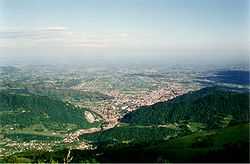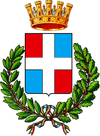Vittorio Veneto
| Vittorio Veneto | ||
|---|---|---|
| Comune | ||
| Città di Vittorio Veneto | ||
 | ||
| ||
 Vittorio Veneto Location of Vittorio Veneto in Italy | ||
| Coordinates: 45°59′N 12°18′E / 45.983°N 12.300°E | ||
| Country | Italy | |
| Region | Veneto | |
| Province | Treviso (TV) | |
| Frazioni | Carpesica, Confin, Cozzuolo, Fadalto, Formeniga, Longhere, Nove, San Giacomo di Veglia | |
| Government | ||
| • Mayor | Roberto Tonon | |
| Area | ||
| • Total | 82 km2 (32 sq mi) | |
| Elevation | 138 m (453 ft) | |
| Population (31 December 2010)[1] | ||
| • Total | 28,964 | |
| • Density | 350/km2 (910/sq mi) | |
| Demonym | Vittoriesi | |
| Time zone | CET (UTC+1) | |
| • Summer (DST) | CEST (UTC+2) | |
| Postal code | 31029 | |
| Dialing code | 0438 | |
| Patron saint | St. Titian and Augusta of Treviso | |
| Saint day | January 16, August 22 | |
| Website | Official website | |
Vittorio Veneto is a city and comune situated in the Province of Treviso, in the region of Veneto, Italy, in the northeast of the Italian peninsula, between the Piave and the Livenza rivers.
Geography
The river Meschio passes down through the town from Serravalle through the district which bears its name. The north of Vittorio Veneto is straddled by mountains including the majestic Col Visentin. To the east is the state park and forest of Cansiglio which summits at Monte Pizzoc; to the west, a hill region including Valdobbiadene, where prosecco wine is produced; and to the south is the commercial town of Conegliano.
History
Ancient
The area was occupied in ancient times by Celts and Veneti.
During the first century BC Emperor Augustus established a Castrum Cenetense in what is now the heart of Serravalle to defend the Venetian plain. The Via Claudia Augusta passed near the city.
The ancient pieve of Sant'Andrea in Bigonzo in the northeast of the city, on the southern end of Serravalle, attests to the presence of Christianity in the area by the 4th century.
Ceneda
Ceneda rose to importance after the destruction of Oderzo by the Lombards in 667 AD. It became the seat of a Lombard county. Near the heart of Ceneda and on a strategic mountain, the Lombards constructed the castello di San Martino which still overlooks the city.
In 685, the Lombard duke Grimoald I of Benevento organized Ceneda into a diocese, assigning to it a large part of the territory that had been under the care of the suppressed diocese of Oderzo. At the foot of the same height upon which the duke's castle had been built, a cathedral was constructed. St. Titian of Oderzo, whose relics are contained in the present cathedral, was named as patron of the diocese.
With the defeat of the Lombards in 774, Ceneda entered into the Frankish sphere. It seems the duke of Ceneda remained loyal to Charlemagne even when the Lombard dukes of Cividale, Treviso, and Vicenza rebelled the following year.
In 994, the Holy Roman Emperor Otto III invested the bishop of Ceneda with the title and prerogatives of count and authority as temporal lord of the city. The bishop of Ceneda was forced to take part in the politics of Northern Italy and even joined the Lombard League. It also faced threats from its neighbors and in the late 12th century was attacked by the commune of Treviso. Only the mediation of the pope led to the restitution of what had been stolen, including the relics of St. Titian.
On December 19, 1389, Ceneda was peacefully incorporated into the Venetian Republic. Its bishops still retained authority as counts. However, in 1447 and in 1514 bishops Francesco and Oliviero, respectively, ceded to the Republic the right of civil investiture within the territory of Ceneda, reserving for themselves and their successors authority over the commune itself and a few villas. The privileges of Ceneda's bishops as counts were definitively revoked by the Republic in 1768. Meanwhile, the commune endured the vicissitudes of neighboring communes of Veneto.
Serravalle
Serravalle, just to the north of Ceneda, owes its origin to the Romans.
In 1174, it became a fief of the Da Camino family.
It rose to its greatest splendor under the rule of the Republic of Venice from 1337 to 1797.
Modern era
On November 22, 1866, soon after the Veneto was annexed by the Kingdom of Italy, Ceneda and Serravalle were joined into one municipality.
In October 1918, Vittorio was the site of the last battle between Italy and Austria-Hungary during World War I. It led to the victory of Italy over the Austro-Hungarian Empire (Austrian-Italian Armistice of Villa Giusti) effective on 4 November 1918.
To recall this crucial victory, "Vittorio", i.e. victorious, was attached to the city's name in 1923. Subsequently, many streets in other parts of Italy have been named Via Vittorio Veneto.
List of (Count)-Bishops of Ceneda/Vittorio Veneto
Bishops of Ceneda
[Some series begin with Vindemius (579-591?), Ursinus (680- ?), and Satinus (731 - ?).]
- Valentinianus (712-740)
- Maximus (741-790)
- Dulcissimus (c.793-?)
- Ermonius (c.827-?)
- Ripaldus (885-908)
Coterminously Bishops of Ceneda and Counts of Ceneda
- Sicardo (962-997), given title of count by Holy Roman Emperor
- Gauso (c.998-?)
- Bruno (1021)
- Elmengero (1021–1031)
- Almanguino (1050)
- Giovanni (1074)
- Roperto (1124)
- Sigismondo (1130)
- Azzone Degli Azzoni (1138–1152)
- Aimone (1152)
- Sgisfredo (1170–1187)
- Matteo Da Siena (1187–1216)
- Gerardo (1217)
- Alberto Da Camino (1220–1242)
- Guarnieri Da Polcenigo (1242–1251)
- Ruggero (1252–1267)
- Biaquino Da Camino (1257)
- Alberto Da Collo (1257–1260)
- Odorico (1260–1261)
- Prosapio Novello (1261–1279)
- Marco Da Fabiane (1279–1285)
- Piero Calza (1286–1300)
- Francesco Arpone (1300–1310), first count of Tarzo
- Manfredo Da Collalto (1310–1320)
- Francesco Ramponi (1320–1348)
- Gualberto De'Orgoglio (1349–1374)
- Oliverio (1374–1377)
- Andrea Calderini (1378-1381?)
- Giorgio Torti (1381–1383)
- Marco De'Porris (1383–1394), after 1389 bishops retain title of count but with duties of civil magistrates of the Venetian Republic
- Martino Franceschini (1394–1399)
- Piero Marcello (1399–1409)
- Antonio Correr (1409–1445)
- Piero Leoni (1445–1474)
- Nicolò Trevisan (1474–1498)
- Francesco Brevio (1498–1508)
- Marino Grimani (1508–1517)
- Domenico Grimani (1517–1520)
- Giovanni Grimani (1520–1531)
- Marino Grimani (1532–1540)
- Giovanni Grimani (1540–1545), second time
- Marino Grimani (1545–1546)
- Michele Della Torre (1547–1586), named cardinal 1583
- MarcAntonio Mocenigo (1586–1597), erected diocesan seminary
- Leonardo Mocenigo (1599–1623)
- Piero cardinal Valier (1623–1625), translated to Padua
- Marco Giustiniani (1625–1631)
- Marc Antonio Bragadin (1631–1639), translated to Vicenza
- Sebastiano Pisani (1639–1653)
- Albertino Barisoni (1653–1667)
- Piero Leoni (1667–1691)
- Marc Antonio Agazzi (1692–1710)
- Francesco Trevisan (1710–1725)
- Benedetto De Luca (1725–1739)
- Lorenzo da Ponte (1740–1768), born Venice, last count-bishop
Culture
Every year, the Concorso Nazionale Corale "Trofei Città di Vittorio Veneto" takes place at Vittorio Veneto. The best choirs from all over Italy compete.
The city is also host to a violin competition.
Language
The local Venetian dialect, called Vittoriese, shares features with the dialects of both Treviso and Belluno.
Characteristics of Vittoriese distinguishing it from Venetian include the frequent dropping of final "o". When this occurs leaving a final "m", the "m" reduces to an "n." For example, Venetian "semo" (we are) become "sen".
The first person singular of verbs ends in "e". Thus, "mi magne" serves for Venetian "mi magno" ("I eat"). Overall, Vittoriese remains intelligible to speakers of other dialects of the Venetian language.
People
- Albino Luciani (Pope John Paul I) – bishop of Vittorio Veneto from 1958 to 1969. Patriarch of Venice 1970-1978, Cardinal 1973-1978. Elected Pope. 26.08.1978. Died 29.09.1978.
- Lorenzo Da Ponte – opera librettist for Wolfgang Amadeus Mozart.
- Ferdinando Botteon (Born 1904); Italian violinist.
- Marcantonio Flaminio (born 1498) – Renaissance humanist.
- Emanuela Da Ros (born 1959) – children's books writer.
- Francesca Segat (born 1983) – Italian butterfly swimmer.
- Giampietro Bontempi – pianist.
- Ilario Castagner – football player.
- Gabriele Pin (born 1962) – football player and coach.
- Andrea Poli (born 1989) – football player.
- Tommaso Benvenuti (rugby union) (born 1990) – rugby union player.
- Amia Venera Landscape – Post-Metal band.
See also
- Battle of Vittorio Veneto
- Order of Vittorio Veneto
- Vittorio Veneto-class battleship
- Cruiser Vittorio Veneto
Twin towns
 São Caetano do Sul, Brazil, since 1984
São Caetano do Sul, Brazil, since 1984 Finale Ligure, Italy, since 1998
Finale Ligure, Italy, since 1998 Criciuma, Brazil, since 2000
Criciuma, Brazil, since 2000
References
- ↑ Population data from Istat
Sources
- Sartori, Basilio (2005). A Ceneda con S. Tiziano Vescovo e i suoi Successori (712-2005). Vittorio Veneto: TIPSE.
External links
| Wikimedia Commons has media related to Vittorio Veneto. |
